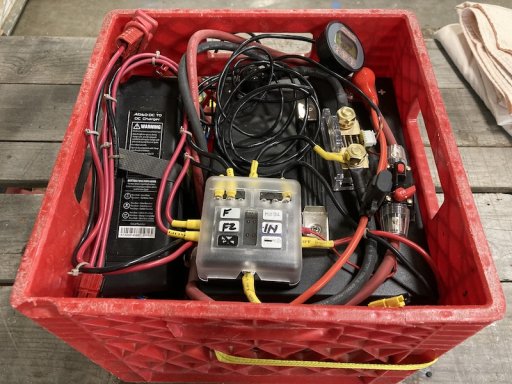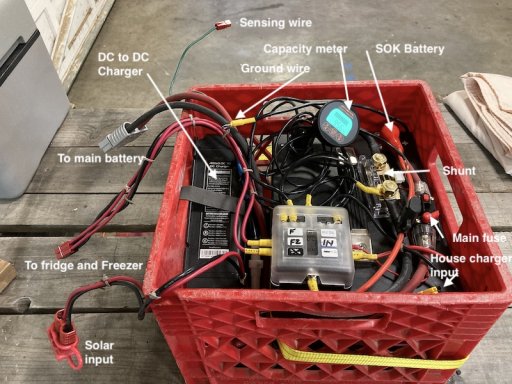
Influencer I
- 3,231
- First Name
- Larrie is
- Last Name
- sharing our travels with the world.
- Member #
-
19319
- Ham/GMRS Callsign
- KG7WDX
Those of you that watch my travel videos know I that I use two different vehicles to go camping in. One is a 2002 Ford E350 camper van and the other is a 2015 Jeep Wrangler Unlimited Rubicon. I move some of my basic camping gear, like sleeping pads and bags, fridge, stove, etc. from one vehicle to the other. No sense in duplicating items. As I started taking longer trips with the Jeep I realized that I needed a second battery system for it. After much research and pricing systems I settled on a lithium setup in a milk crate after watching a Will Prowse video. The advantage of this system is that it can be moved to either vehicle. The parts I purchased were not all the ones in the video.
Parts List
DC to DC charger: Kisae DMT 1250 fifty amp, dual input (alternator/solar) charger.
Battery: SOK 100 amp LiFePO4
Capacity meter: AiLi Voltmeter Ammeter Voltage Current Meter Voltmeter Ammeter
Assorted Anderson plugs
Wire
Fuse box
Main circuit breaker at battery: RKURCK 80 Amp Circuit Breaker Manual Reset Inline Fuse
120 volt to 12 volt converter: DROK AC 110V-220V to DC 0-48V Converter
The DC to DC charger was recommended by a friend that specializes in 12 volt electrical systems. It is more expensive that some. The advantage to me was that it has a sensing line that tells the charger when the engine is running so the lithium battery does not suck the juice out of the starter battery. The built in MPPT solar charger is also a nice Unit charges from one source at a time. I also like that it can be set to charge at anywhere from 5 to 50 amps in 5 amp increments.
The SOK battery was the only battery I could find that was 100 amp and would fit in the milk crate.
The power converter is only used at home top up the battery before a trip.
On a recent trip to southern Utah, in the Jeep, I had my fridge and a small freezer running off the system. The freezer ran almost continuously in the 80 F weather. During the day the Jeep would fully charge the system in about two hours of driving. We camped around 4:00 pm and started again around 9:00 am. Combined the fridge and freezer used about 20% of the battery capacity during the time we were parked.
Am happy with the way the system works. The only issue I had was with the circuit breaker in the engine bay where the system connected to the starting battery. The engine bay would get hot and the thermals in the circuit breaker would trip it. It was annoying to have to reset it. I will be changing that breaker to a different one.
On a side note, my electronic devices are charged while driving. I added multiple USB and 12 volt outlets to both vehicles. The only device I charge at night is my watch. The main power draws in the van are the fridge, heater, and Fantastic Fan. I have a 400 watt inverter that is only use while driving to charge my laptop.
Packed for travel

Power connections

Parts List
DC to DC charger: Kisae DMT 1250 fifty amp, dual input (alternator/solar) charger.
Battery: SOK 100 amp LiFePO4
Capacity meter: AiLi Voltmeter Ammeter Voltage Current Meter Voltmeter Ammeter
Assorted Anderson plugs
Wire
Fuse box
Main circuit breaker at battery: RKURCK 80 Amp Circuit Breaker Manual Reset Inline Fuse
120 volt to 12 volt converter: DROK AC 110V-220V to DC 0-48V Converter
The DC to DC charger was recommended by a friend that specializes in 12 volt electrical systems. It is more expensive that some. The advantage to me was that it has a sensing line that tells the charger when the engine is running so the lithium battery does not suck the juice out of the starter battery. The built in MPPT solar charger is also a nice Unit charges from one source at a time. I also like that it can be set to charge at anywhere from 5 to 50 amps in 5 amp increments.
The SOK battery was the only battery I could find that was 100 amp and would fit in the milk crate.
The power converter is only used at home top up the battery before a trip.
On a recent trip to southern Utah, in the Jeep, I had my fridge and a small freezer running off the system. The freezer ran almost continuously in the 80 F weather. During the day the Jeep would fully charge the system in about two hours of driving. We camped around 4:00 pm and started again around 9:00 am. Combined the fridge and freezer used about 20% of the battery capacity during the time we were parked.
Am happy with the way the system works. The only issue I had was with the circuit breaker in the engine bay where the system connected to the starting battery. The engine bay would get hot and the thermals in the circuit breaker would trip it. It was annoying to have to reset it. I will be changing that breaker to a different one.
On a side note, my electronic devices are charged while driving. I added multiple USB and 12 volt outlets to both vehicles. The only device I charge at night is my watch. The main power draws in the van are the fridge, heater, and Fantastic Fan. I have a 400 watt inverter that is only use while driving to charge my laptop.
Packed for travel

Power connections


